Tim Dockhorn
Fast High-Resolution Image Synthesis with Latent Adversarial Diffusion Distillation
Mar 18, 2024Abstract:Diffusion models are the main driver of progress in image and video synthesis, but suffer from slow inference speed. Distillation methods, like the recently introduced adversarial diffusion distillation (ADD) aim to shift the model from many-shot to single-step inference, albeit at the cost of expensive and difficult optimization due to its reliance on a fixed pretrained DINOv2 discriminator. We introduce Latent Adversarial Diffusion Distillation (LADD), a novel distillation approach overcoming the limitations of ADD. In contrast to pixel-based ADD, LADD utilizes generative features from pretrained latent diffusion models. This approach simplifies training and enhances performance, enabling high-resolution multi-aspect ratio image synthesis. We apply LADD to Stable Diffusion 3 (8B) to obtain SD3-Turbo, a fast model that matches the performance of state-of-the-art text-to-image generators using only four unguided sampling steps. Moreover, we systematically investigate its scaling behavior and demonstrate LADD's effectiveness in various applications such as image editing and inpainting.
Scaling Rectified Flow Transformers for High-Resolution Image Synthesis
Mar 05, 2024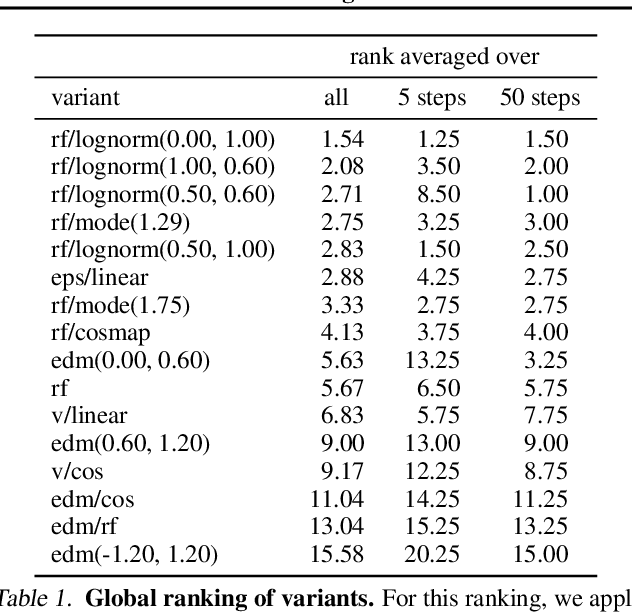
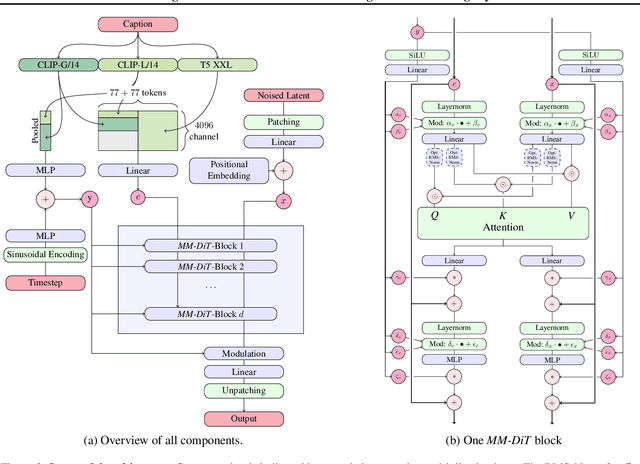
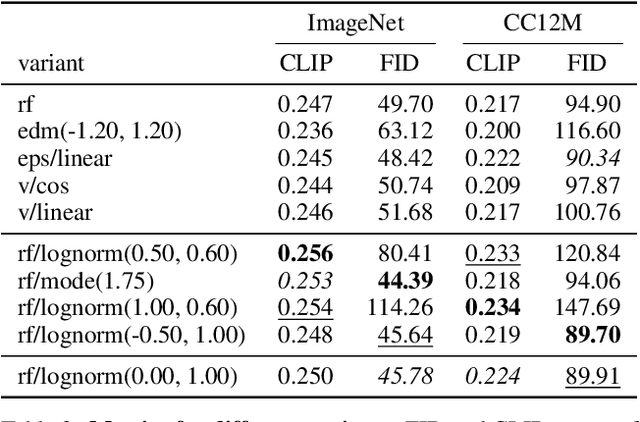
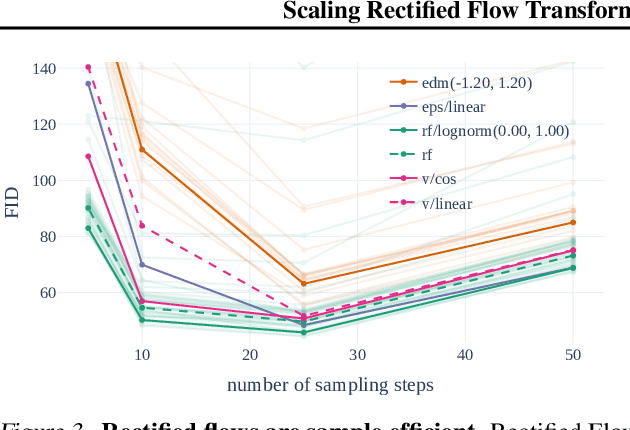
Abstract:Diffusion models create data from noise by inverting the forward paths of data towards noise and have emerged as a powerful generative modeling technique for high-dimensional, perceptual data such as images and videos. Rectified flow is a recent generative model formulation that connects data and noise in a straight line. Despite its better theoretical properties and conceptual simplicity, it is not yet decisively established as standard practice. In this work, we improve existing noise sampling techniques for training rectified flow models by biasing them towards perceptually relevant scales. Through a large-scale study, we demonstrate the superior performance of this approach compared to established diffusion formulations for high-resolution text-to-image synthesis. Additionally, we present a novel transformer-based architecture for text-to-image generation that uses separate weights for the two modalities and enables a bidirectional flow of information between image and text tokens, improving text comprehension, typography, and human preference ratings. We demonstrate that this architecture follows predictable scaling trends and correlates lower validation loss to improved text-to-image synthesis as measured by various metrics and human evaluations. Our largest models outperform state-of-the-art models, and we will make our experimental data, code, and model weights publicly available.
Stable Video Diffusion: Scaling Latent Video Diffusion Models to Large Datasets
Nov 25, 2023



Abstract:We present Stable Video Diffusion - a latent video diffusion model for high-resolution, state-of-the-art text-to-video and image-to-video generation. Recently, latent diffusion models trained for 2D image synthesis have been turned into generative video models by inserting temporal layers and finetuning them on small, high-quality video datasets. However, training methods in the literature vary widely, and the field has yet to agree on a unified strategy for curating video data. In this paper, we identify and evaluate three different stages for successful training of video LDMs: text-to-image pretraining, video pretraining, and high-quality video finetuning. Furthermore, we demonstrate the necessity of a well-curated pretraining dataset for generating high-quality videos and present a systematic curation process to train a strong base model, including captioning and filtering strategies. We then explore the impact of finetuning our base model on high-quality data and train a text-to-video model that is competitive with closed-source video generation. We also show that our base model provides a powerful motion representation for downstream tasks such as image-to-video generation and adaptability to camera motion-specific LoRA modules. Finally, we demonstrate that our model provides a strong multi-view 3D-prior and can serve as a base to finetune a multi-view diffusion model that jointly generates multiple views of objects in a feedforward fashion, outperforming image-based methods at a fraction of their compute budget. We release code and model weights at https://github.com/Stability-AI/generative-models .
SDXL: Improving Latent Diffusion Models for High-Resolution Image Synthesis
Jul 04, 2023

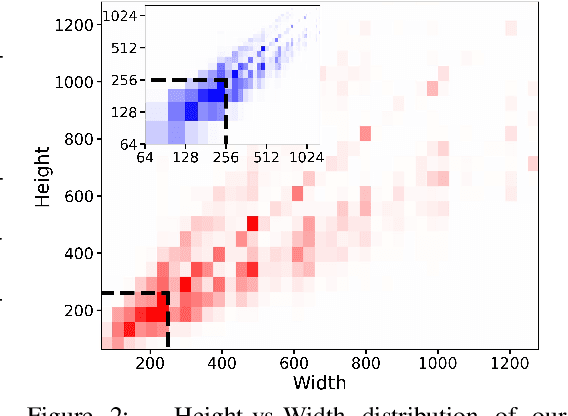
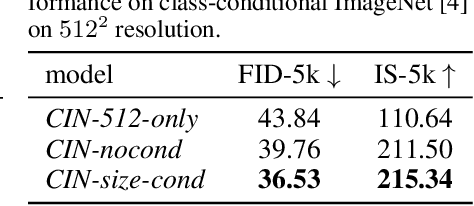
Abstract:We present SDXL, a latent diffusion model for text-to-image synthesis. Compared to previous versions of Stable Diffusion, SDXL leverages a three times larger UNet backbone: The increase of model parameters is mainly due to more attention blocks and a larger cross-attention context as SDXL uses a second text encoder. We design multiple novel conditioning schemes and train SDXL on multiple aspect ratios. We also introduce a refinement model which is used to improve the visual fidelity of samples generated by SDXL using a post-hoc image-to-image technique. We demonstrate that SDXL shows drastically improved performance compared the previous versions of Stable Diffusion and achieves results competitive with those of black-box state-of-the-art image generators. In the spirit of promoting open research and fostering transparency in large model training and evaluation, we provide access to code and model weights at https://github.com/Stability-AI/generative-models
Align your Latents: High-Resolution Video Synthesis with Latent Diffusion Models
Apr 18, 2023Abstract:Latent Diffusion Models (LDMs) enable high-quality image synthesis while avoiding excessive compute demands by training a diffusion model in a compressed lower-dimensional latent space. Here, we apply the LDM paradigm to high-resolution video generation, a particularly resource-intensive task. We first pre-train an LDM on images only; then, we turn the image generator into a video generator by introducing a temporal dimension to the latent space diffusion model and fine-tuning on encoded image sequences, i.e., videos. Similarly, we temporally align diffusion model upsamplers, turning them into temporally consistent video super resolution models. We focus on two relevant real-world applications: Simulation of in-the-wild driving data and creative content creation with text-to-video modeling. In particular, we validate our Video LDM on real driving videos of resolution 512 x 1024, achieving state-of-the-art performance. Furthermore, our approach can easily leverage off-the-shelf pre-trained image LDMs, as we only need to train a temporal alignment model in that case. Doing so, we turn the publicly available, state-of-the-art text-to-image LDM Stable Diffusion into an efficient and expressive text-to-video model with resolution up to 1280 x 2048. We show that the temporal layers trained in this way generalize to different fine-tuned text-to-image LDMs. Utilizing this property, we show the first results for personalized text-to-video generation, opening exciting directions for future content creation. Project page: https://research.nvidia.com/labs/toronto-ai/VideoLDM/
Latent Space Diffusion Models of Cryo-EM Structures
Nov 25, 2022Abstract:Cryo-electron microscopy (cryo-EM) is unique among tools in structural biology in its ability to image large, dynamic protein complexes. Key to this ability is image processing algorithms for heterogeneous cryo-EM reconstruction, including recent deep learning-based approaches. The state-of-the-art method cryoDRGN uses a Variational Autoencoder (VAE) framework to learn a continuous distribution of protein structures from single particle cryo-EM imaging data. While cryoDRGN can model complex structural motions, the Gaussian prior distribution of the VAE fails to match the aggregate approximate posterior, which prevents generative sampling of structures especially for multi-modal distributions (e.g. compositional heterogeneity). Here, we train a diffusion model as an expressive, learnable prior in the cryoDRGN framework. Our approach learns a high-quality generative model over molecular conformations directly from cryo-EM imaging data. We show the ability to sample from the model on two synthetic and two real datasets, where samples accurately follow the data distribution unlike samples from the VAE prior distribution. We also demonstrate how the diffusion model prior can be leveraged for fast latent space traversal and interpolation between states of interest. By learning an accurate model of the data distribution, our method unlocks tools in generative modeling, sampling, and distribution analysis for heterogeneous cryo-EM ensembles.
Differentially Private Diffusion Models
Oct 18, 2022



Abstract:While modern machine learning models rely on increasingly large training datasets, data is often limited in privacy-sensitive domains. Generative models trained with differential privacy (DP) on sensitive data can sidestep this challenge, providing access to synthetic data instead. However, training DP generative models is highly challenging due to the noise injected into training to enforce DP. We propose to leverage diffusion models (DMs), an emerging class of deep generative models, and introduce Differentially Private Diffusion Models (DPDMs), which enforce privacy using differentially private stochastic gradient descent (DP-SGD). We motivate why DP-SGD is well suited for training DPDMs, and thoroughly investigate the DM parameterization and the sampling algorithm, which turn out to be crucial ingredients in DPDMs. Furthermore, we propose noise multiplicity, a simple yet powerful modification of the DM training objective tailored to the DP setting to boost performance. We validate our novel DPDMs on widely-used image generation benchmarks and achieve state-of-the-art (SOTA) performance by large margins. For example, on MNIST we improve the SOTA FID from 48.4 to 5.01 and downstream classification accuracy from 83.2% to 98.1% for the privacy setting DP-$(\varepsilon{=}10, \delta{=}10^{-5})$. Moreover, on standard benchmarks, classifiers trained on DPDM-generated synthetic data perform on par with task-specific DP-SGD-trained classifiers, which has not been demonstrated before for DP generative models. Project page and code: https://nv-tlabs.github.io/DPDM.
GENIE: Higher-Order Denoising Diffusion Solvers
Oct 11, 2022



Abstract:Denoising diffusion models (DDMs) have emerged as a powerful class of generative models. A forward diffusion process slowly perturbs the data, while a deep model learns to gradually denoise. Synthesis amounts to solving a differential equation (DE) defined by the learnt model. Solving the DE requires slow iterative solvers for high-quality generation. In this work, we propose Higher-Order Denoising Diffusion Solvers (GENIE): Based on truncated Taylor methods, we derive a novel higher-order solver that significantly accelerates synthesis. Our solver relies on higher-order gradients of the perturbed data distribution, that is, higher-order score functions. In practice, only Jacobian-vector products (JVPs) are required and we propose to extract them from the first-order score network via automatic differentiation. We then distill the JVPs into a separate neural network that allows us to efficiently compute the necessary higher-order terms for our novel sampler during synthesis. We only need to train a small additional head on top of the first-order score network. We validate GENIE on multiple image generation benchmarks and demonstrate that GENIE outperforms all previous solvers. Unlike recent methods that fundamentally alter the generation process in DDMs, our GENIE solves the true generative DE and still enables applications such as encoding and guided sampling. Project page and code: https://nv-tlabs.github.io/GENIE.
Score-Based Generative Modeling with Critically-Damped Langevin Diffusion
Dec 30, 2021



Abstract:Score-based generative models (SGMs) have demonstrated remarkable synthesis quality. SGMs rely on a diffusion process that gradually perturbs the data towards a tractable distribution, while the generative model learns to denoise. The complexity of this denoising task is, apart from the data distribution itself, uniquely determined by the diffusion process. We argue that current SGMs employ overly simplistic diffusions, leading to unnecessarily complex denoising processes, which limit generative modeling performance. Based on connections to statistical mechanics, we propose a novel critically-damped Langevin diffusion (CLD) and show that CLD-based SGMs achieve superior performance. CLD can be interpreted as running a joint diffusion in an extended space, where the auxiliary variables can be considered "velocities" that are coupled to the data variables as in Hamiltonian dynamics. We derive a novel score matching objective for CLD and show that the model only needs to learn the score function of the conditional distribution of the velocity given data, an easier task than learning scores of the data directly. We also derive a new sampling scheme for efficient synthesis from CLD-based diffusion models. We find that CLD outperforms previous SGMs in synthesis quality for similar network architectures and sampling compute budgets. We show that our novel sampler for CLD significantly outperforms solvers such as Euler--Maruyama. Our framework provides new insights into score-based denoising diffusion models and can be readily used for high-resolution image synthesis. Project page and code: https://nv-tlabs.github.io/CLD-SGM.
Demystifying and Generalizing BinaryConnect
Oct 25, 2021
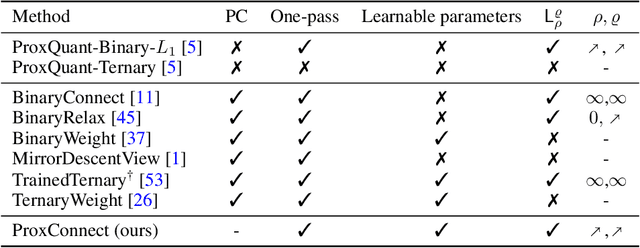


Abstract:BinaryConnect (BC) and its many variations have become the de facto standard for neural network quantization. However, our understanding of the inner workings of BC is still quite limited. We attempt to close this gap in four different aspects: (a) we show that existing quantization algorithms, including post-training quantization, are surprisingly similar to each other; (b) we argue for proximal maps as a natural family of quantizers that is both easy to design and analyze; (c) we refine the observation that BC is a special case of dual averaging, which itself is a special case of the generalized conditional gradient algorithm; (d) consequently, we propose ProxConnect (PC) as a generalization of BC and we prove its convergence properties by exploiting the established connections. We conduct experiments on CIFAR-10 and ImageNet, and verify that PC achieves competitive performance.
 Add to Chrome
Add to Chrome Add to Firefox
Add to Firefox Add to Edge
Add to Edge